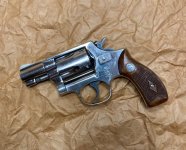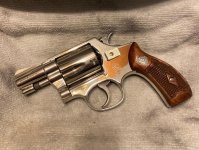Here is my process - it is pretty basic.
1. I remove the cylinder, thumb piece, and grips, then scrub the exterior (frame, barrel, cylinder and yoke) with an old soft toothbrush and Hoppes 9, and if needed run a bore brush with Hoppes 9 down the barrel and each of the cylinder charge holes (followed by a Bore Snake).
2. Rarely, but if I think it needs it (sluggish trigger return or gritty feel in the trigger pull), I may also remove the side plate and interiors and clean, lube, then reassemble (only do this if you know how to properly remove the side plate and the internals).
3. If there is any surface rust or spots, I very carefully tackle those areas with some fine
bronze/copper wool and a little oil (NOTE: steel wool of any grade will scratch and remove the finish of a steel gun - the finer the wool, the finer the scratches).
4. I then wipe all the parts dry, and give them a
very, very light buff with Flitz (a very small amount applied on, and pressed into the fabric of an old T-shirt).
[EDITED to NOTE: This step is generally only performed when I get a new-to-me gun. As noted by various posters in this thread - Flitz is an abrasive and if used often or agressively, it will remove the bluing.]
5. Next I wipe everything (any Flitz or Hoppes residue) off with an old soft clean T-shirt.
6. Next - I apply a very thin coat of Renaissance Wax with my finger or thumb, let it dry, then buff with a micro-fiber cloth to a shine.
7. I also clean the grips with a clean soft toothbrush and if needed clean the grip screw, escutcheons and medallions with a q-tip lightly damp (almost dry) with Hoppes - then wipe the grips off and
may (depending on the desired patina of the grips) polish the smooth parts lightly with a bit of Flitz on an old T-shirt (do not get any Flitz in the checkering).
8. The grips also get a coat of Ren Wax (not in the checkering) and a micro-fiber buff till they shine.
9. Next I lightly lightly oil (more is not better) the moving parts, and reassemble the gun and grips.
10. Lastly and most importantly, once fully assembled, I sit back and admire the beauty that is S&W - this may include a lighted magnifying glass (particularly with engraved guns) and micro-fiber buffing, or spot cleaning (Q-Tip damp (not wet) with Hoppes) any of the places that did not get perfectly clean or may have a bit of the Ren Wax that did not get buffed.

Some may take exception with some (or all) of my process, but it works for me and by the time I'm finished, I have gotten to know every centimeter of the gun.

A little OCD, but part of the fun for me.
A few photos of the end results:














